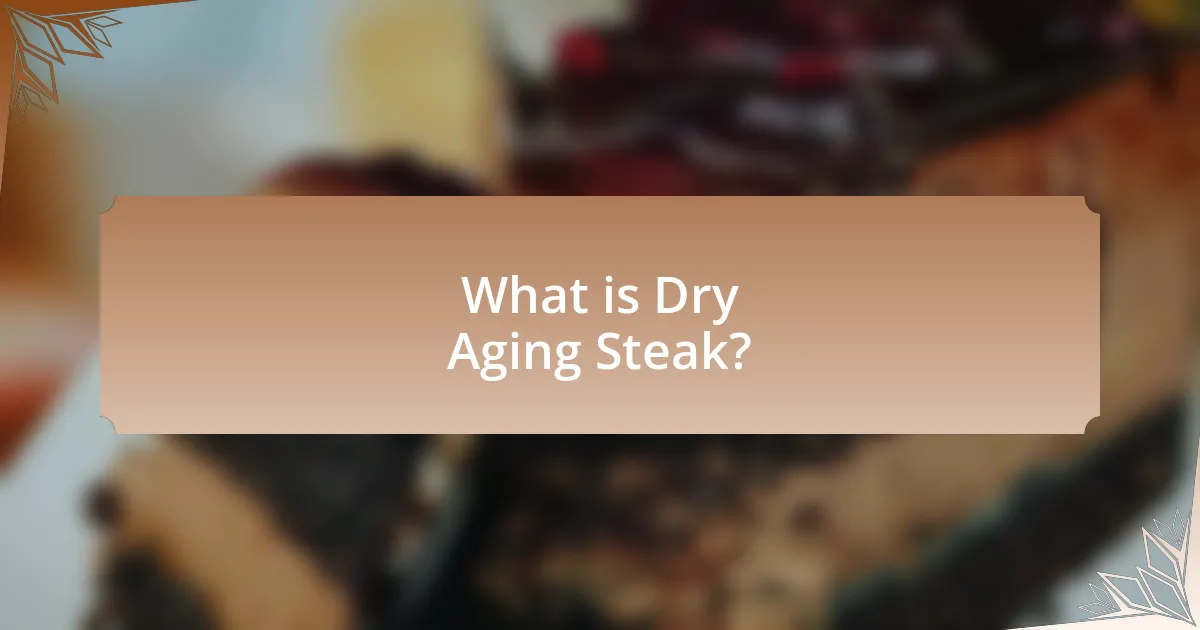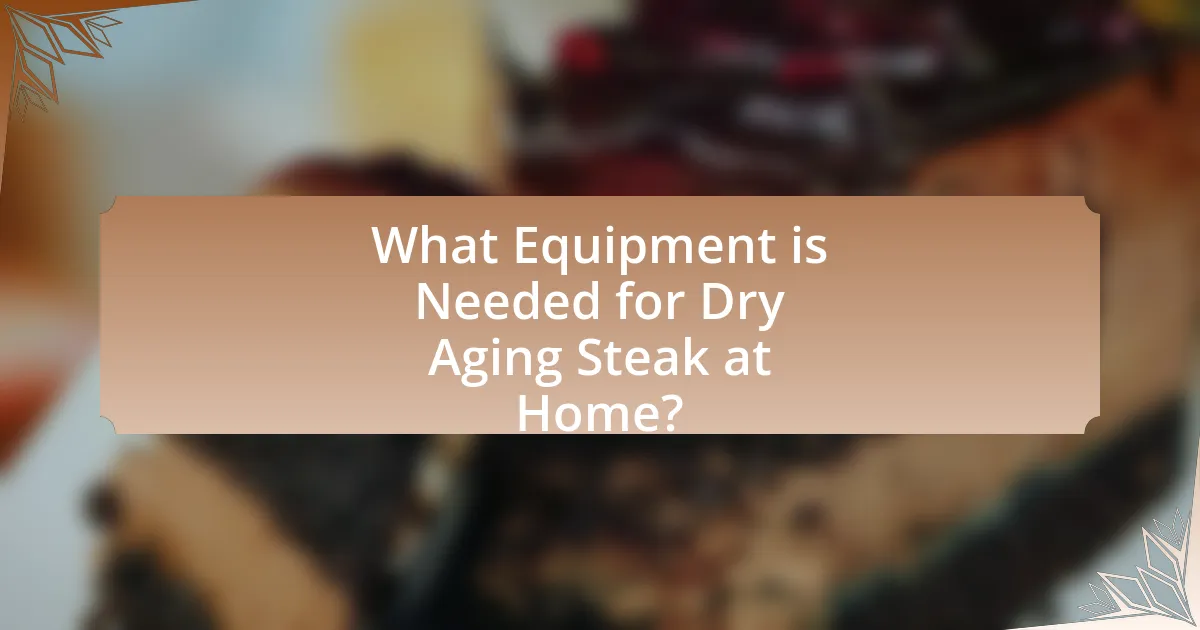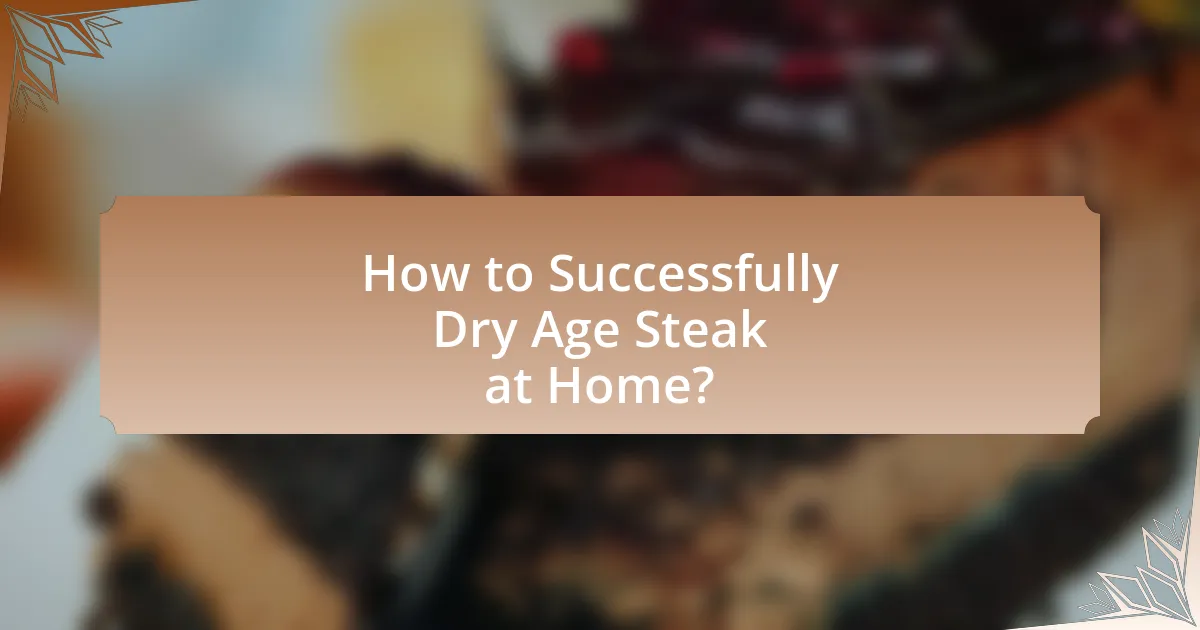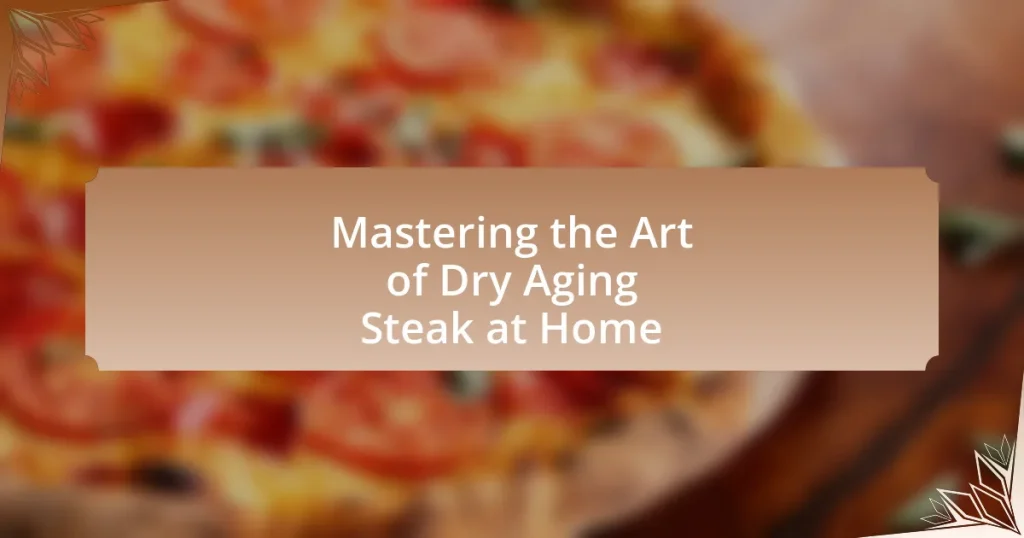Dry aging steak is a culinary technique that enhances the flavor and tenderness of beef by allowing it to rest in a controlled environment for 14 to 60 days. This process involves moisture evaporation and enzymatic breakdown of muscle tissue, resulting in a concentrated flavor profile and improved texture. The article covers the key stages of dry aging, the benefits of this method compared to wet aging, essential equipment needed for home aging, safety measures, and best practices for cooking and serving dry aged steak. It also addresses common mistakes to avoid and provides guidance on how to successfully dry age steak at home.

What is Dry Aging Steak?
Dry aging steak is a process that enhances the flavor and tenderness of beef by allowing it to rest in a controlled, chilled environment for an extended period, typically ranging from 14 to 60 days. During this time, natural enzymes break down muscle tissue, resulting in a more concentrated flavor and improved texture. The process also involves moisture evaporation, which intensifies the beef’s taste. Studies have shown that dry-aged beef can have a more robust flavor profile compared to wet-aged beef, making it a preferred choice for many culinary enthusiasts.
How does the dry aging process work?
The dry aging process works by allowing beef to rest in a controlled, chilled environment for an extended period, typically between 14 to 60 days. During this time, moisture evaporates from the meat, concentrating its flavor and enhancing tenderness through natural enzymatic breakdown of muscle fibers. The ideal conditions for dry aging include a temperature range of 34°F to 38°F, humidity levels around 80%, and proper air circulation, which together prevent spoilage and promote the development of desirable flavors. Studies have shown that dry aging can significantly improve the taste and texture of beef, making it a preferred method among chefs and meat enthusiasts.
What are the key stages of dry aging steak?
The key stages of dry aging steak include the selection of high-quality meat, controlled aging environment, moisture evaporation, enzymatic breakdown, and flavor development. Initially, a whole primal cut, typically ribeye or strip loin, is chosen for its marbling and quality. The meat is then placed in a temperature and humidity-controlled environment, usually between 34°F to 38°F with humidity around 80%, to facilitate moisture evaporation. During the aging process, which can last from a few weeks to several months, natural enzymes break down muscle fibers, resulting in increased tenderness. Concurrently, the concentration of flavors intensifies as moisture is lost, leading to a richer taste profile. This process is scientifically supported by the understanding of enzymatic activity and moisture loss in meat aging, which enhances both texture and flavor.
How does moisture loss affect the steak during aging?
Moisture loss during steak aging leads to concentration of flavors and improved tenderness. As the steak loses moisture, the proteins and fats become more concentrated, enhancing the overall taste profile. Additionally, the reduction in moisture creates a firmer texture, which is often associated with high-quality aged beef. Studies indicate that dry aging can result in a weight loss of approximately 15-20% due to moisture evaporation, which directly correlates with the intensified flavor and tenderness experienced in the final product.
What are the benefits of dry aging steak?
The benefits of dry aging steak include enhanced flavor, improved tenderness, and increased juiciness. Dry aging allows natural enzymes to break down muscle tissue, resulting in a more tender texture. Additionally, the process concentrates the beef’s flavor as moisture evaporates, leading to a richer taste profile. Studies have shown that dry-aged beef can have a more pronounced umami flavor due to the development of complex compounds during the aging process. Furthermore, the Maillard reaction, which occurs during cooking, is intensified in dry-aged steak, contributing to a more appealing crust and aroma.
How does dry aging enhance flavor and tenderness?
Dry aging enhances flavor and tenderness by allowing natural enzymes in the meat to break down muscle fibers and connective tissue, resulting in a more tender texture. During the dry aging process, moisture evaporates from the meat, concentrating its flavor and promoting the development of complex, nutty, and beefy notes through enzymatic and microbial activity. Research indicates that dry aging can improve tenderness by up to 30% compared to fresh meat, as the enzymatic breakdown significantly softens the meat’s structure.
What differences can be observed between dry aged and wet aged steak?
Dry aged steak and wet aged steak differ primarily in their aging processes, which significantly affect flavor and texture. Dry aging involves hanging the meat in a controlled, chilled environment with low humidity, allowing moisture to evaporate and enzymes to break down muscle tissue, resulting in a concentrated flavor and firmer texture. In contrast, wet aging occurs in vacuum-sealed bags, where the meat retains moisture, leading to a milder flavor and more tender texture due to the preservation of juices. Studies indicate that dry aged steak can develop a nutty, beefy flavor profile, while wet aged steak tends to have a fresher taste.

What Equipment is Needed for Dry Aging Steak at Home?
To dry age steak at home, the essential equipment needed includes a dedicated refrigerator or dry aging fridge, a wire rack, and a hygrometer. A dedicated refrigerator or dry aging fridge maintains the optimal temperature and humidity levels required for the aging process, typically around 34-38°F and 80-85% humidity. A wire rack allows for proper air circulation around the meat, which is crucial for even aging. A hygrometer measures humidity levels, ensuring they remain within the ideal range to prevent spoilage and promote the development of flavor. These components collectively create the controlled environment necessary for successful dry aging.
What are the essential tools for dry aging steak?
The essential tools for dry aging steak include a dedicated dry aging refrigerator, a humidity control system, and a meat thermometer. A dedicated dry aging refrigerator maintains the optimal temperature and airflow, crucial for the aging process, while a humidity control system ensures the right moisture levels to prevent spoilage. A meat thermometer is necessary to monitor the internal temperature of the steak, ensuring it remains within the safe range during aging. These tools collectively create an environment that promotes the development of flavor and tenderness in the meat, which is supported by culinary practices emphasizing controlled aging conditions.
How do you choose the right refrigerator for dry aging?
To choose the right refrigerator for dry aging, select a unit that maintains a consistent temperature between 34°F and 38°F, with humidity levels around 80-85%. This temperature range is crucial for preventing spoilage while allowing the meat to age properly. Additionally, ensure the refrigerator has good air circulation and a dedicated fan to promote even drying and prevent mold growth. Models specifically designed for dry aging, such as those with built-in humidity controls and UV lighting, can enhance the aging process by providing optimal conditions.
What role does humidity control play in the aging process?
Humidity control plays a crucial role in the aging process of steak by preventing excessive moisture loss and promoting optimal enzymatic activity. Maintaining a humidity level between 80% and 85% during dry aging allows the meat to develop flavor and tenderness without drying out. Research indicates that proper humidity levels help inhibit the growth of undesirable bacteria while allowing beneficial microorganisms to thrive, which enhances the aging process. This balance is essential for achieving the desired texture and taste in dry-aged steak.
What safety measures should be taken during the dry aging process?
During the dry aging process, it is essential to maintain strict hygiene and temperature control to ensure food safety. The meat should be stored in a dedicated refrigerator that maintains a temperature between 34°F and 38°F (1°C to 3°C) to inhibit bacterial growth. Additionally, the environment should have low humidity levels, ideally around 80%, to prevent spoilage while allowing moisture to evaporate from the meat.
Using a fan to circulate air within the aging chamber can further reduce the risk of mold and bacteria. Regularly monitoring the meat for any off odors or unusual colors is crucial, as these can indicate spoilage. Furthermore, it is important to use high-quality, fresh cuts of meat and to avoid cross-contamination by ensuring that all surfaces and utensils are sanitized before and after handling the meat. These measures collectively help ensure that the dry aging process is safe and effective.
How can you prevent spoilage while dry aging at home?
To prevent spoilage while dry aging at home, maintain a controlled environment with specific temperature and humidity levels. The ideal temperature for dry aging is between 34°F and 38°F (1°C to 3°C), while humidity should be around 80% to 85%. This range inhibits bacterial growth and promotes the development of flavor and tenderness. Additionally, using a dedicated refrigerator or a dry aging bag can help regulate these conditions effectively. Research indicates that proper airflow is also crucial, as it prevents moisture accumulation, which can lead to spoilage.
What are the signs of a properly aged steak?
The signs of a properly aged steak include a deep, rich color, typically a dark red or purplish hue, indicating enhanced flavor development. Additionally, the surface of the steak may exhibit a slightly dry texture, which is a result of moisture loss during the aging process, concentrating the flavors. A properly aged steak also has a firm texture, as the muscle fibers break down, making the meat more tender. The aroma of the steak should be rich and beefy, without any off-putting smells, signaling that the aging process has been successful. These characteristics are essential indicators of quality in dry-aged steaks, as they reflect the biochemical changes that occur during aging, enhancing both flavor and tenderness.

How to Successfully Dry Age Steak at Home?
To successfully dry age steak at home, select a high-quality cut of beef, such as ribeye or strip loin, and ensure it has a good amount of fat and bone. Place the steak on a wire rack in a refrigerator that maintains a consistent temperature between 34°F and 38°F (1°C to 3°C) with good air circulation. The steak should be left to age for a minimum of 21 days, but aging for 30 to 45 days enhances flavor and tenderness. During this period, moisture evaporates, concentrating the beef’s flavor, while enzymes break down muscle tissue, improving tenderness. Properly dry aging requires monitoring humidity levels, ideally around 80%, to prevent spoilage. Using a dedicated aging fridge or a modified refrigerator can help maintain these conditions effectively.
What steps should be followed to dry age steak at home?
To dry age steak at home, follow these steps: First, select a high-quality cut of beef, preferably a bone-in ribeye or strip loin, as these cuts age better. Next, ensure proper air circulation by placing the steak on a wire rack in a dedicated refrigerator or a cooler with temperature control, maintaining a temperature between 34°F and 38°F. Then, monitor humidity levels, aiming for around 80%, which can be achieved using a small humidifier or by placing a pan of water in the fridge. Allow the steak to age for a minimum of 21 days, but up to 60 days for more intense flavor. Finally, trim off the dried outer layer before cooking. This method is supported by culinary experts who emphasize the importance of temperature and humidity control in the aging process for optimal flavor and tenderness.
How do you prepare the steak for the aging process?
To prepare the steak for the aging process, first select a high-quality cut of beef, such as ribeye or strip loin, which has a good amount of marbling. Next, trim any excess fat and remove silver skin to ensure even aging and prevent spoilage. After trimming, season the steak lightly with salt to enhance flavor and moisture retention during aging. Finally, place the steak in a controlled environment, ideally at a temperature of 34-38°F with low humidity, to facilitate the dry aging process. This method is supported by culinary practices that emphasize the importance of proper cut selection and environmental conditions for optimal aging results.
What is the ideal aging time for different cuts of steak?
The ideal aging time for different cuts of steak varies: ribeye and strip steak benefit from 21 to 28 days of aging, while tenderloin is best aged for 14 to 21 days. Aging enhances flavor and tenderness by allowing enzymes to break down muscle fibers. Research indicates that aging beyond 28 days can lead to excessive moisture loss and undesirable flavors, making the 21 to 28-day range optimal for ribeye and strip cuts. For tenderloin, the shorter aging period of 14 to 21 days strikes a balance between tenderness and flavor enhancement.
What common mistakes should be avoided when dry aging steak?
Common mistakes to avoid when dry aging steak include using the wrong cut of meat, neglecting proper temperature and humidity control, and failing to monitor airflow. Using cuts like ribeye or strip loin is essential, as they have sufficient fat and muscle structure to withstand the aging process. Maintaining a temperature between 34°F and 38°F and humidity around 80% is crucial to prevent spoilage and ensure optimal aging. Additionally, ensuring adequate airflow around the meat prevents mold growth and promotes even drying. These factors are critical for achieving the desired flavor and tenderness in dry-aged steak.
How can improper temperature affect the aging process?
Improper temperature can significantly disrupt the aging process of steak by promoting undesirable bacterial growth and affecting enzymatic activity. When steak is aged at temperatures above the recommended range of 34°F to 38°F, harmful bacteria can thrive, leading to spoilage and food safety risks. Conversely, temperatures that are too low can slow down the enzymatic reactions necessary for tenderizing the meat and developing flavor, resulting in a less desirable product. Research indicates that maintaining optimal aging temperatures is crucial for achieving the desired texture and taste, as enzymes break down muscle fibers and connective tissues, enhancing tenderness and flavor complexity.
What should you do if your steak develops an off smell?
If your steak develops an off smell, you should discard it immediately. An off smell indicates spoilage, which can result from bacterial growth or improper storage. Consuming spoiled meat can lead to foodborne illnesses, as studies show that harmful bacteria can proliferate in improperly aged or stored steak. Therefore, it is crucial to prioritize food safety and avoid consuming any steak that exhibits unusual odors.
What are the best practices for serving dry aged steak?
The best practices for serving dry aged steak include allowing the steak to rest at room temperature before cooking, seasoning it simply with salt and pepper, and cooking it to the desired doneness using high heat methods such as grilling or pan-searing. Allowing the steak to rest for 30 to 60 minutes before cooking enhances flavor and tenderness by promoting even cooking. Simple seasoning is recommended to highlight the rich, concentrated flavors developed during the aging process. Cooking at high heat creates a desirable crust while preserving the juicy interior. These practices ensure that the unique qualities of dry aged steak are fully appreciated.
How should dry aged steak be cooked for optimal flavor?
Dry aged steak should be cooked using high heat methods such as grilling or pan-searing to enhance its rich flavor. These cooking techniques allow for a caramelized crust to form, which complements the concentrated flavors developed during the aging process. Cooking the steak to an internal temperature of 130-135°F for medium-rare ensures optimal tenderness and juiciness, as recommended by culinary experts. This temperature range allows the natural flavors to shine while maintaining the steak’s moisture.
What side dishes pair well with dry aged steak?
Classic side dishes that pair well with dry aged steak include roasted vegetables, creamy mashed potatoes, and sautéed mushrooms. Roasted vegetables, such as asparagus or Brussels sprouts, complement the rich flavor of dry aged steak, enhancing its umami profile. Creamy mashed potatoes provide a smooth texture that balances the steak’s robust taste, while sautéed mushrooms add an earthy element that harmonizes with the meat’s depth. These combinations are favored in culinary practices due to their ability to elevate the dining experience by contrasting and complementing the steak’s unique characteristics.










